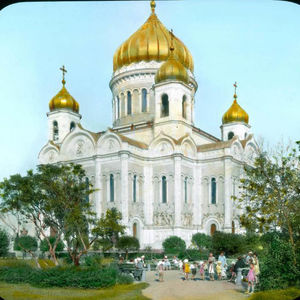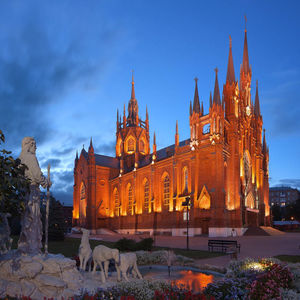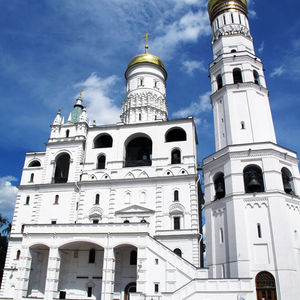Moscow cathedrals and churches
Besides the famous Orthodox monasteries (of which there are hundreds), Moscow synagogues, Catholic churches, and mosques have also found their home in the city. The onion domes of St. Basil’s Cathedral have become a kind of symbol of Russia due to their widespread use in brochures and by travel agencies. St. Basil’s has earned its spot, however, and is deserving of its own tour. The cathedral’s architecture and structure are representative of Orthodox churches, with the immediately recognizable silhouettes of their cupolas, but differ greatly from European structures. Additionally, Moscow churches might reflect other stylistic influences, including Baroque and Art Nouveau (most notable in the Pokrovsky Cathedral and Convent of Martha and Mary).
The fate of many Moscow churches during the Soviet period is regrettable — if a church wasn’t demolished, it was converted to meet other needs. For example, some churches were repurposed as warehouses, movie theaters, or factories, among other things. During the period of perestroika, the effort to restore Moscow’s churches became much stronger. Perhaps the most textbook example of the Soviet state’s relationship with its churches is the Cathedral of Christ the Savior, which was blown up in 1933, only to be rebuilt from scratch in 1995.
Below are some of the most important and beautiful cathedrals Moscow has to offer.
Cathedral of Christ the Savior
Cathedral of Christ the Savior - this is a metropolitan cathedral of the Russian Orthodox Church that has, arguably, lived through the largest number of transformations. It was built on money given by the people in honor of the victory over Napoleon in 1812. It was built over 50 years and only stood for 60 years. In 1931, the Soviet government blew up the cathedral, a tragedy in world history. Different parts of the interior from the ruined cathedral can still be found in different corners of Moscow.
The location of the Cathedral itself, on the bank of the Moscow River, seems to be contain a mystery – nothing stay there for very long. The Monastery of St. Alexius was removed to make way for it. After that, the Cathedral itself experienced the same fate, making way for Stalin’s most significant project – the Palace of the Soviets. But that was not fated to materialize, and after a lengthy state of neglect the gigantic Moskva Pool. However, it did not live for very long – 34 years. In 1995, the Cathedral was erected again.
You can see this corner of Moscow on our themed tour and assess to what extent this new building of concrete and bronze matches the original, how well the original concept was preserved, and what the complex and very deep story told by the Cathedral means.
Cathedral of the Immaculate Conception of the Blessed Virgin Mary
Cathedral of the Immaculate Conception of the Blessed Virgin Mary – this is the main Catholic cathedral in Moscow (and in Russia), which surprises with its unusual, neo-Gothic appearance, was built using money from Moscow’s Polish community from 1901-1911 (incidentally, the site to build it was not chosen at random).
Despite the fact that it is under the jurisdiction of the Roman Catholic Church, it did not escape the fate of Orhtodox churches in Soviet times: it was shut down, fell into ruin, used as a dormitory, and then given over to a research institute that – after a complicated process – only left the premises in 1996.
Today, the Cathedral of the Immaculate Conception is a stunning example of Gothicism in Moscow (something rare, and therefore more meaningful). It is also one of two places where Moscow’s Catholics can attend mass in their native language.
Our guides follow a special route that covers a visit to the cathedral as part of a tour of Moscow’s Gothic architecture, or a tour to see sights associated with the city’s religious communities.
Ivan the Great Bell Tower
The Ivan the Great Bell Tower (1590, built by Bon Fryazin) is the Kremlin’s first high-rise building, and Moscow’s back then, built by Italian architect Bon Fryazin in honor of Prince Ivan III the Great.
The bell tower was built and rebuilt anew over the course of 100 years; at the start of the 17th century, it was already 81 meters in height.
The ensemble of the bell tower and church lived through a lot, including being blown up on Napoleon’s orders as he was leaving Moscow. The bell tower withstood the blast, and the church was rebuilt.
Cathedral of the Assumption (Dormition) of Moscow Kremlin
The Cathedral of the Assumption (Uspensky in Russian), 1479, architect Aristotele Fioravanti, was the main cathedral in Russia before the Cathedral of Christ the Savior was constructed; it is an example of outstanding work performed by Italian architects in Moscow.
It is one of Moscow’s oldest buildings in terms of preserving its original appearance.
The role of the cathedral in the country’s history is enormous; here, rulers were crowned as czars, and church hierarchs elevated in rank. The church also has one of the oldest necropolises.






















